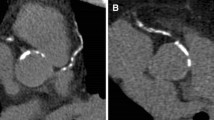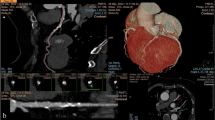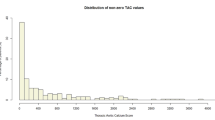Abstract
Objective
To evaluate the association between aortic arch calcifications (AAC) on chest radiography and coronary artery calcium (CAC) score determined by CT.
Methods
A total of 128 patients (75 men; 69.3 ± 14.7 years) who underwent chest radiography and CAC scoring at CT were included in this retrospective analysis. The extent of AAC on chest radiography was evaluated independently by two blinded observers using a semi-quantitative four-point scale (0–3). Intra- and interobserver agreement was assessed by weighted ĸ statistics. Amount of AAC determined on radiography was correlated with CAC and ROC analyses performed to characterise the diagnostic performance of AAC grading.
Results
Excellent intraobserver (ĸ = 0.82) and good interobserver (ĸ = 0.75) agreement of AAC grading was noted. Moderate agreement (ĸ = 0.46, 95 % CI 0.36–0.56) with a linear trend (P < 0.0001) between AAC grades and CAC scores was found. Cut-off between AAC grades 0–2 and 3 had a sensitivity of 38.6 %, specificity of 96.4 %, PPV of 85.0 %, NPV of 75.0 % and accuracy of 76.6 % for the correct identification of CAC scores greater than 400.
Conclusion
Semi-quantitative AAC grading on chest radiography is reliable and positively associated with CAC scoring. We propose to report the extent of AAC in comprehensive radiological reports as “not present”, “moderate” or “severe”, as severe AAC strongly suggests coronary artery calcification.
Key Points
• Semi-quantitative aortic arch calcification (AAC) grading on plain chest radiography appears reliable.
• AAC grading is positively associated with CT coronary artery calcium scoring.
• AAC grading has a high specificity for ruling out CAC scores greater than 400.
• We propose the reporting of the extent of AAC grade in chest X-ray (CXR) reports.




Similar content being viewed by others
References
O'Rourke M (1995) Mechanical principles in arterial disease. Hypertension 26(1):2–9
Ehara S, Kobayashi Y, Yoshiyama M et al (2004) Spotty calcification typifies the culprit plaque in patients with acute myocardial infarction: an intravascular ultrasound study. Circulation 110:3424–3429
Ehara S, Kobayashi Y, Yoshiyama M, Ueda M, Yoshikawa J (2006) Coronary artery calcification revisited. J Atheroscler Thromb 13:31–37
Wilson PW, Kauppila LI, O'Donnell CJ et al (2001) Abdominal aortic calcific deposits are an important predictor of vascular morbidity and mortality. Circulation 103:1529–1534
Iijima K, Hashimoto H, Hashimoto M et al (2010) Aortic arch calcification detectable on chest X-ray is a strong independent predictor of cardiovascular events beyond traditional risk factors. Atherosclerosis 210:137–144
Witteman JC, Kok FJ, van Saase JL, Valkenburg HA (1986) Aortic calcification as a predictor of cardiovascular mortality. Lancet 2:1120–1122
Iribarren C, Sidney S, Sternfeld B, Browner WS (2000) Calcification of the aortic arch: risk factors and association with coronary heart disease, stroke, and peripheral vascular disease. JAMA 283:2810–2815
Hashimoto H, Iijima K, Hashimoto M et al (2009) Validity and usefulness of aortic arch calcification in chest X-ray. J Atheroscler Thromb 16:256–264
Rumberger JA, Sheedy PF, Breen JF, Schwartz RS (1997) Electron beam computed tomographic coronary calcium score cutpoints and severity of associated angiographic lumen stenosis. J Am Coll Cardiol 29:1542–1548
Kondos GT, Hoff JA, Sevrukov A et al (2003) Electron-beam tomography coronary artery calcium and cardiac events: a 37-month follow-up of 5635 initially asymptomatic low- to intermediate-risk adults. Circulation 107:2571–2576
Shemesh J, Henschke CI, Shaham D et al (2010) Ordinal scoring of coronary artery calcifications on low-dose CT scans of the chest is predictive of death from cardiovascular disease. Radiology 257:541–548
Rumberger JA, Brundage BH, Rader DJ, Kondos G (1999) Electron beam computed tomographic coronary calcium scanning: a review and guidelines for use in asymptomatic persons. Mayo Clin Proc 74:243–252
Shemesh J, Koren-Morag N, Apter S et al (2004) Accelerated progression of coronary calcification: four-year follow-up in patients with stable coronary artery disease. Radiology 233:201–209
Becker CR (2005) Estimation of cardiac event risk by MDCT. Eur Radiol 15(Suppl 2):B17–22
Adler Y, Fisman EZ, Shemesh J et al (2004) Spiral computed tomography evidence of close correlation between coronary and thoracic aorta calcifications. Atherosclerosis 176:133–138
Eisen A, Tenenbaum A, Koren-Morag N et al (2008) Calcification of the thoracic aorta as detected by spiral computed tomography among stable angina pectoris patients: association with cardiovascular events and death. Circulation 118:1328–1334
Mahnken AH, Wein BB, Sinha AM, Gunther RW, Wildberger JE (2009) Value of conventional chest radiography for the detection of coronary calcifications: comparison with MSCT. Eur J Radiol 69:510–516
Agatston AS, Janowitz WR, Hildner FJ, Zusmer NR, Viamonte M Jr, Detrano R (1990) Quantification of coronary artery calcium using ultrafast computed tomography. J Am Coll Cardiol 15:827–832
Landis JR, Koch GG (1977) The measurement of observer agreement for categorical data. Biometrics 33:159–174
Shaw LJ, Raggi P, Schisterman E, Berman DS, Callister TQ (2003) Prognostic value of cardiac risk factors and coronary artery calcium screening for all-cause mortality. Radiology 228:826–833
Raggi P, Callister TQ, Cooil B et al (2000) Identification of patients at increased risk of first unheralded acute myocardial infarction by electron-beam computed tomography. Circulation 101:850–855
Breen JF, Sheedy PF 2nd, Schwartz RS et al (1992) Coronary artery calcification detected with ultrafast CT as an indication of coronary artery disease. Radiology 185:435–439
Hasdai D, Bell MR, Grill DE et al (1997) Outcome > or = 10 years after successful percutaneous transluminal coronary angioplasty. Am J Cardiol 79:1005–1011
Lanhede B, Bath M, Kheddache S et al (2002) The influence of different technique factors on image quality of chest radiographs as evaluated by modified CEC image quality criteria. Br J Radiol 75:38–49
Sardanelli F, Di Leo G (2009) Biostatistics for radiologists: planning, performing, and writing a radiologic study. Springer Verlag, Milan
Author information
Authors and Affiliations
Corresponding author
Rights and permissions
About this article
Cite this article
Bannas, P., Jung, C., Blanke, P. et al. Severe aortic arch calcification depicted on chest radiography strongly suggests coronary artery calcification. Eur Radiol 23, 2652–2657 (2013). https://doi.org/10.1007/s00330-013-2877-z
Received:
Revised:
Accepted:
Published:
Issue Date:
DOI: https://doi.org/10.1007/s00330-013-2877-z




